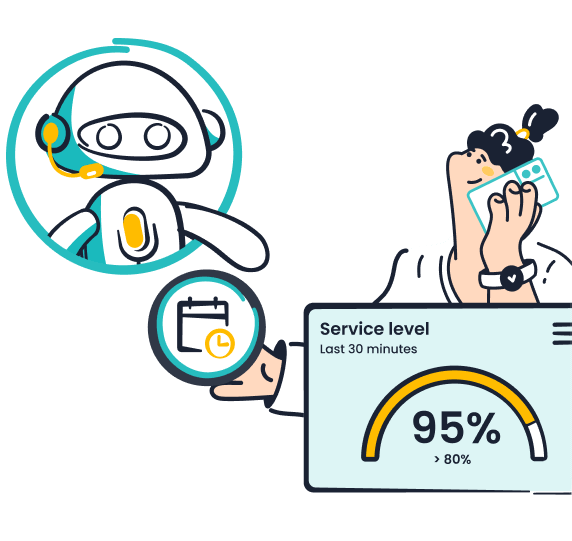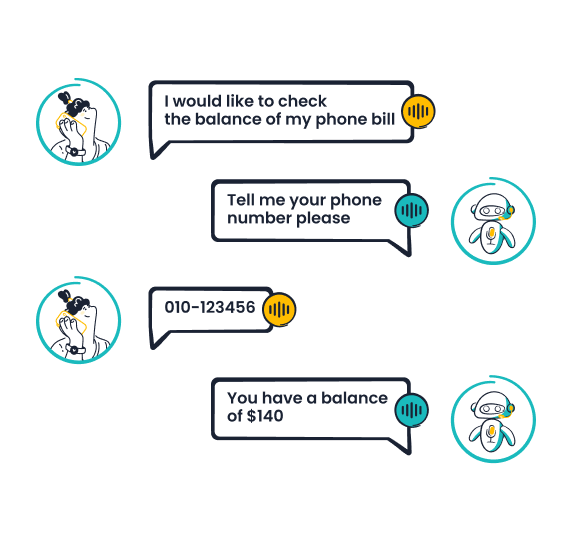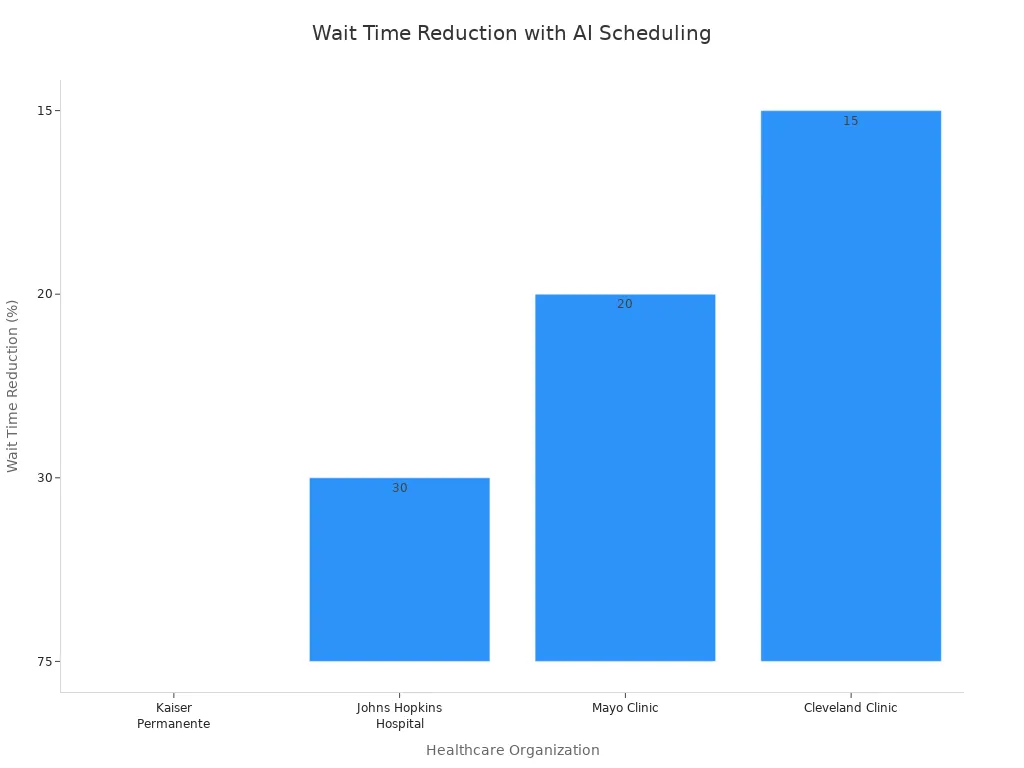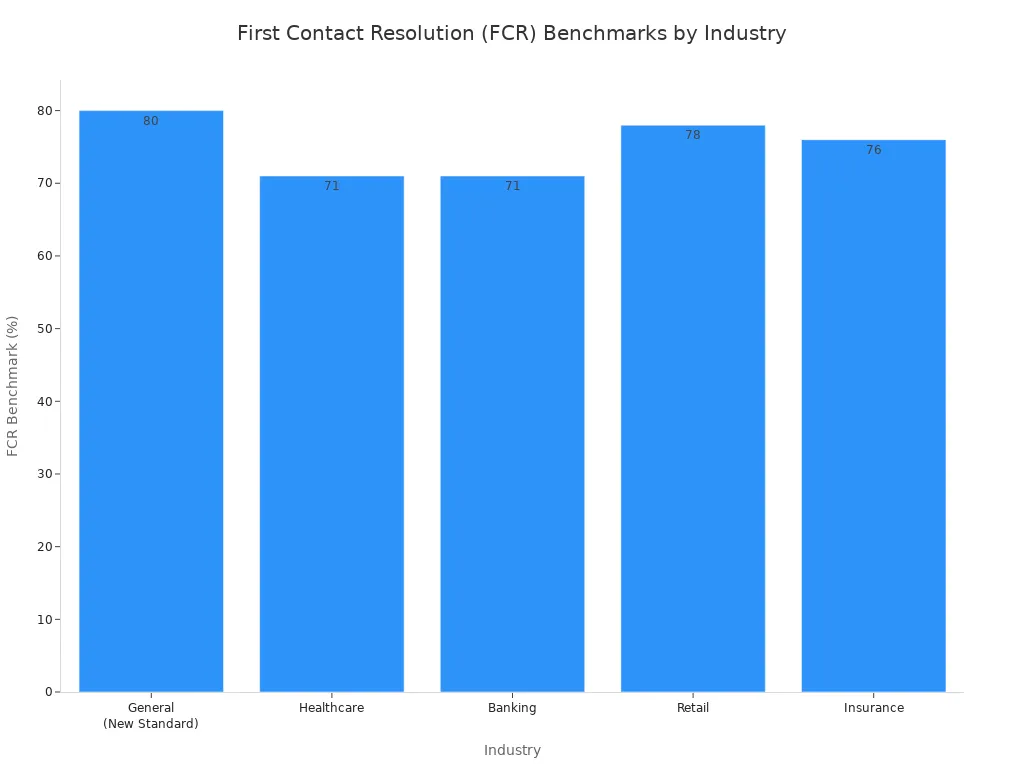Reduce Long Wait Times With These 10 Pro Tips

A long wait time is more than an inconvenience; it damages your brand and drives your best customer away. This poor call center experience hurts customer loyalty, especially since slow service causes 68% of customer cancellations.
Acquiring a new customer costs 5 to 25 times more than retaining an existing one.
You can reduce wait times with a strategy combining smart technology, like the Sobot call center and Sobot AI, with optimized support. This guide offers actionable ways to reduce customer hold time. You will deliver a quality experience, boost customer satisfaction, and improve your overall service. Sobot is here to help you achieve higher customer satisfaction.
TIP 1: Offer a Smart Call-Back System
Instead of forcing a customer to wait on hold, you can offer customer callbacks. This simple option dramatically improves the service experience. It shows you respect their time, which builds trust and loyalty.
How Call-Backs Work
Callbacks allow a customer to request a return call when an agent becomes available. They can hang up and continue their day without losing their place in the queue. This feature is incredibly popular.
A significant majority of customers, specifically 75%, express a preference for a call-back option rather than enduring a wait in a queue.
By providing callbacks, you reduce abandoned calls and improve overall customer satisfaction. It turns a frustrating wait into a positive interaction. You can offer customer callbacks through your IVR system or on your website.
Choosing Call-Back Technology
Selecting the right technology is key to implementing effective callbacks. Your system should integrate smoothly with your existing tools, like your CRM. This gives agents the context they need for a high-quality conversation. When comparing software, look for a solution that can grow with your business.
Consider these factors when making your choice:
| Factor | What to Consider |
|---|---|
| Scalability | Will the software grow with your business needs? |
| Integrations | Does it integrate with your existing systems? |
| Customizability | Can you tailor the software to meet your needs? |
| Ease of Use | Is the interface intuitive for your team? |
| Budget | Does the cost align with your financial resources? |
| Security | Are there sufficient measures to protect your data? |
Implementation Best Practices
To maximize the benefits of callbacks, set clear expectations. Inform the customer of the estimated wait time for their return call. Always follow through on that promise to maintain trust. Train your agents to handle callbacks efficiently, ensuring they have all necessary information before making the call. This preparation leads to faster resolutions and boosts customer satisfaction.
TIP 2: Leverage AI for Instant Triage
You can use Artificial Intelligence (AI) to sort incoming customer requests instantly. This strategy dramatically cuts down the time a customer spends waiting for help. AI acts as the first point of contact, resolving simple issues on the spot.
Automate Common Queries
AI tools like chatbots and voicebots excel at handling frequent, simple questions. You can deploy them to answer queries about order status, password resets, or store hours. This automation provides immediate answers, which boosts customer satisfaction. Sobot’s AI Chatbot and Voicebot can handle these routine tasks 24/7. This frees your team and provides a better service experience.
AI-powered tools can have a significant impact on your key metrics. Studies show that businesses using AI see impressive results.
| Metric | Potential Improvement with AI |
|---|---|
| Wait Times | Reduce by up to 60% |
| Call Volume | Lower by up to 30% during peak hours |
| Agent Productivity | Increase by 30–45% |
Free Up Human Agents
When AI handles repetitive tasks, your human agents can focus on complex problems that require empathy and critical thinking. This shift is a game-changer for your support team. Instead of being overwhelmed with basic questions, agents apply their skills where they matter most. This leads to higher-quality interactions and faster resolutions for the customer who needs detailed help. Ultimately, this smart allocation of resources builds customer loyalty.
Integrate with Sobot's Voicebot

Integrating a powerful AI solution is simple. The Sobot Voicebot uses advanced technology to understand and respond to a customer just like a human would. Because Sobot's AI is ChatGPT-enabled and multilingual, you can offer seamless, intelligent support to a global audience around the clock. This ensures every customer receives a high-quality and consistent service experience, strengthening their connection to your brand.
TIP 3: Optimize Staffing to Reduce Wait Times

Technology alone cannot solve long queues. You must also optimize your staffing to match customer demand. Smart scheduling ensures you have the right number of agents working at the right times. This balance is key to providing fast and effective support.
Forecast Peak Volume
You can predict when your team will be busiest by analyzing data. Understanding your peak hours helps you prepare for high call volumes. Use forecasting methods to get an accurate picture of your needs.
Pro Tip: Effective forecasting uses several data sources to build a complete picture.
- Time Series Analysis: You can use historical call data to find patterns. This helps you see trends and seasonal rushes.
- Machine Learning and AI: These advanced tools analyze data to find hidden patterns. They can even factor in marketing campaigns or social media trends for better accuracy.
- Bottom-Up Forecasting: You can forecast needs for smaller segments, like specific channels or agent skills. Combining these gives you a detailed overall prediction.
Create Data-Driven Schedules
After you forecast demand, you can create schedules that meet it. Data-driven scheduling helps you avoid being understaffed during a rush or overstaffed during slow periods. Using AI and predictive analytics for scheduling can produce dramatic results, leading to higher quality service. As organizations like Kaiser Permanente and Johns Hopkins have shown, this approach significantly cuts wait times and improves customer satisfaction.

Use Flexible Staffing Models
Flexible staffing helps you adapt to changing call volumes without hiring more full-time agents. This strategy allows you to scale your team up or down as needed. It is a cost-effective way to ensure every customer gets timely help. This responsiveness builds customer loyalty and boosts customer satisfaction.
Consider these flexible models:
- Hybrid Staffing: Use a core team of permanent employees and bring in freelancers for specific projects or skills.
- Variable Staffing: Hire temporary staff during predictable peak seasons, such as holidays in the retail industry.
- Part-Time Roles: Use part-time agents to cover specific shifts, like the lunch hour rush or evening hours.
TIP 4: Build an Actionable Self-Service Knowledge Base
You can empower your customers to find answers on their own. An effective knowledge base is a powerful tool for deflecting common inquiries and reducing your call queue. This approach provides instant support and improves overall customer satisfaction.
Identify Key Content
First, you must understand your customer needs. Analyze your support tickets and call logs to find the most frequent questions. This data shows you exactly what content to create. Focus on building an actionable resource that provides clear, step-by-step solutions. Each article should solve a specific problem, helping a customer get back on track quickly. This proactive approach to service builds trust and long-term loyalty.
Design for Easy Navigation
A great knowledge base is easy to use. If a customer cannot find information, the resource is useless. You should design your self-service portal for intuitive navigation.
- Use a prominent search bar. Place it front and center so users can find it instantly.
- Organize content logically. Group related articles into clear, sensible categories.
- Create helpful signposts. Use interlinking between articles to guide users to related topics.
A well-organized structure ensures every customer can find what they need. This focus on a quality user experience is essential for successful self-service adoption.
Promote Self-Service Options
You need to guide your customers to your knowledge base. Make your self-service portal the easiest and fastest path to a solution. You can promote it in your IVR messages, on your website, and in agent email signatures. A positive first experience is critical for adoption.
When you provide a seamless and effective self-service experience, you not only reduce wait times but also boost customer satisfaction. This strategy delivers a better service experience for everyone.
TIP 5: Route Customers with an Effective IVR
An Interactive Voice Response (IVR) system can be your first line of defense against long queues. When designed well, it guides a customer to the right solution quickly. A poorly designed IVR, however, creates frustration and drives callers away. The key is to build a system that helps, not hinders.
Design a Customer-Centric IVR
You should build your IVR menu around your customer needs. Start by analyzing why people call you. This data helps you create simple, logical paths to the most common solutions. A customer-centric approach focuses on getting the caller an answer with minimal effort. This positive first interaction sets the stage for a quality support experience. It shows you value their time, which is essential for building customer loyalty. True personalization in your IVR can make a customer feel understood from the very first moment.
Avoid Common IVR Mistakes
Many IVR systems create a poor experience because they fall into common traps. You can improve customer satisfaction by avoiding these mistakes. A great system provides clear, relevant options and an easy way to reach a human agent if needed.
A frustrating IVR menu is a fast track to losing a customer. Ensure your system avoids these pitfalls.
- Confusing or Complex Menus: Keep your options simple and limited. Too many choices overwhelm callers.
- Difficulty Reaching a Live Agent: Always provide a clear, easy option to speak with a person. Trapping a caller in a loop destroys trust.
- Irrelevant Menu Options: Offer choices that match the reasons your customers are calling.
- Poor Voice Recognition: Use technology that accurately understands what your callers are saying to prevent misrouted calls.
Integrate IVR with Self-Service
You can make your IVR even more powerful by connecting it to your other support tools. Integrate your IVR with your knowledge base to offer automated answers to simple questions. For example, your IVR can send a customer a text message with a link to a help article. This use of self-service deflects calls from your agents and empowers callers to find answers instantly. This integration provides a seamless path to resolution and delivers the personalized service modern consumers expect.
TIP 6: Train for First-Contact Resolution
You can significantly shorten your queues by solving a customer issue on the first attempt. This is called First-Contact Resolution (FCR). When you resolve problems quickly, the customer does not need to call back. This focus on efficiency improves the entire support experience.
Link FCR to Shorter Queues
Achieving a high rate of first call resolution directly reduces your overall call volume. When your team resolves an issue completely, that customer is removed from the queue for good. This frees up your agents to help the next person waiting. A higher FCR rate means fewer repeat calls, which optimizes how you use your resources.
For every 1% increase in first call resolution, you can see a 1% decrease in operating costs. This happens because your team spends less time on follow-up calls and more time on new inquiries.
Boost First-Contact Resolution for Customer Satisfaction
Solving a problem on the first try is one of the best ways to improve customer satisfaction. It shows the customer that you are competent and that you value their time. This positive experience builds strong customer loyalty. For example, luxury brand Michael Kors used Sobot's unified platform to empower its agents. This change helped them achieve an impressive 95% customer satisfaction rate, partly by equipping agents to solve issues on the first contact.
Empower Agents with Tools
You must give your agents the right tools to achieve first call resolution. A unified platform is essential for providing quality service. It gives your team a complete view of every customer interaction. With the right technology, agents can deliver fast and accurate solutions.
- Unified Dashboards: Give agents a single screen with all customer data, history, and previous interactions.
- CRM Integration: Connect your support platform to your CRM to provide agents with context about purchases and preferences.
- Internal Knowledge Base: Provide instant access to articles and guides that help agents solve problems quickly.
Sobot’s all-in-one platform bundles these features, empowering your team to handle any inquiry effectively from the very first interaction.
TIP 7: Expand with Sobot's Omnichannel Solution
You can break free from phone-only support. Offering more ways for a customer to contact you is a smart strategy to reduce a long wait time. When you provide an omnichannel communication experience, you give people choices. This approach improves the entire customer experience and builds lasting loyalty.
Reduce Phone Bottlenecks
Relying only on phone calls creates bottlenecks. You can ease this pressure by offering digital support channels. This move caters to different customer preferences and boosts efficiency.
- Expanding your channels beyond the phone helps reduce call volume.
- You can redirect simple questions to tools like chatbots or self-service pages.
- Fewer routine calls free up your agents to handle complex issues, improving resolution times.
This strategy is crucial because a wait of over 10 minutes can cause customer satisfaction to drop from 95% to 70%. Sobot's omnichannel solution routes inquiries to the right agent instantly, streamlining your service delivery.
Choose the Right Channels
You must choose channels that fit your audience and brand. Two in five US consumers use three or more channels to contact a company. You need to be where your customer is. Consider these factors when deciding which channels to offer:
- Know Your Customer: Understand their demographics and tech-savviness. Ask them directly how they prefer to communicate.
- Align with Your Brand: Select channels that match your company’s image and values.
- Assess the Cost: Evaluate the financial needs for technology and staffing for each channel.
This thoughtful selection ensures you invest in the right tools to provide a quality support experience.
Ensure a Consistent Experience
A customer expects a consistent experience no matter how they contact you. Sobot’s Omnichannel Solution unifies all your channels into one workspace. This integration allows for true personalization. Agents see the full history of every interaction, so the customer never has to repeat themselves. When you provide an omnichannel communication experience, you create a seamless journey that boosts customer satisfaction and strengthens your brand.
TIP 8: Proactive Communication to Prevent Long Wait Times

You can get ahead of problems by communicating with your customers first. When you face a service issue or an outage, proactive alerts stop a flood of calls. This strategy prevents a long wait time and shows your customer you are in control. It is a simple way to build trust and maintain high customer satisfaction.
Channels for Proactive Alerts
You should use multiple channels to send your alerts. This ensures your message reaches the widest possible audience. A multi-channel approach provides a quality experience because people can see the update on their preferred platform.
- Website Banners: Place a clear, visible banner at the top of your homepage.
- Email and SMS: Send direct messages to your registered users.
- Social Media: Post updates on platforms like X (formerly Twitter) and Facebook.
- In-App Notifications: Use push notifications if you have a mobile application.
Craft Clear Outage Messages
Your messages must be clear, concise, and helpful. A confusing alert will only create more questions. You should tell people what is happening, what you are doing to fix it, and when you expect a resolution. This transparency builds loyalty. You can also use customer feedback to refine your messaging over time.
Pro Tip: A great outage message is empathetic and informative.
- Acknowledge the Problem: "We are currently experiencing a service disruption affecting our website."
- Explain the Impact: "You may be unable to log in or access your account at this time."
- Provide an Update: "Our team is working to resolve this issue and we expect to be back online within the hour."
- Apologize and Thank: "We apologize for the inconvenience and thank you for your patience."
How Alerts Reduce Call Surges
Proactive alerts directly reduce the number of incoming calls and support tickets. When customers know you are aware of an issue, they are less likely to contact you. This frees up your agents to help people with other urgent problems. Managing expectations this way is key to improving customer satisfaction. You can analyze customer feedback after an event to see how well your communication strategy worked.
TIP 9: Analyze Metrics to Fix Bottlenecks
You cannot fix problems you cannot see. Analyzing your support data helps you find the hidden bottlenecks that cause long wait times. This data-driven approach allows you to make smart changes that improve your service and build customer loyalty.
Track Essential Metrics
Key metrics to watch include:
- Average Handle Time (AHT)
- First Contact Resolution (FCR)
- Average Wait Time (AWT)
- Peak hour traffic
- Average hold time
A strong FCR rate is a sign of a quality team. While the general industry standard is around 77%, aiming for 80% or higher sets a new standard for excellence.

Pinpoint Process Inefficiencies
Once you have the data, you can find your weak spots. A high Average Handle Time (AHT) might mean your agents need better tools or training. A long average hold time could point to understaffing during busy periods. You should investigate why certain numbers are high or low. This investigation, combined with customer feedback, helps you uncover the root cause of delays. For example, if many calls are being transferred, your IVR routing may be ineffective.
Turn Insights into Improvements
Data is only useful when you act on it. You can turn your insights into real improvements for your team and customers. Start by defining clear goals, like reducing wait times by 20%. Then, use your data and customer feedback to create a plan. This might involve updating your internal knowledge base or providing new training to agents. By continuously monitoring your metrics, you can see if your changes are working and make adjustments. This cycle of analysis and action is key to boosting customer satisfaction.
TIP 10: Use an Internal Knowledge Base
You can empower your agents to solve problems faster with a well-organized internal knowledge base. This tool acts as a single source of truth for your team. It gives them instant access to accurate information, which is essential for providing quality service.
Internal vs. External Bases
An internal knowledge base is different from the one your customers use. Your external base is for self-service. Your internal base is a private resource built specifically for your support agents. It contains detailed technical guides, proven troubleshooting steps, and internal policy information. This separation ensures your team has the expert-level details they need without overwhelming customers.
Reduce Agent Handle Time
Agents often spend too much time searching for answers. In fact, many agents spend a large part of a customer call just looking up information. This hunt for solutions makes the customer wait. An internal knowledge base eliminates this delay.
By giving agents a way to find information quickly, you can reduce Average Handle Time (AHT) by 15-25%.
When your agents resolve issues faster, they can move to the next customer more quickly. This efficiency is a simple way to reduce hold time across your entire support system.
Build an Effective Resource
A great internal knowledge base boosts agent confidence and improves performance. When agents trust their resources, they deliver better service, leading to higher customer satisfaction. Organizations with effective knowledge systems see significantly better results.
To build a useful resource, you should:
- Keep it updated. Regularly review and refresh content to ensure accuracy.
- Make it searchable. Use a powerful search function so agents can find answers in seconds.
- Gather feedback. Allow agents to rate articles and suggest improvements.
A well-informed agent can provide a higher degree of personalization, building customer loyalty with every interaction. This investment in your team directly enhances the customer experience and boosts overall customer satisfaction.
You can conquer the long wait time. This guide showed you how to use technology like AI, optimize processes for efficiency, and empower your teams and customers. Reducing queues is an achievable goal that creates a better experience. It directly boosts customer satisfaction and builds lasting customer loyalty. This focus on service strengthens brand loyalty.
Ready to transform your customer service?
Explore how Sobot's all-in-one solutions can help. Book your demo today or contact us at marketing@sobot.io to get started.
FAQ
What is the fastest way to reduce customer wait times?
You can see immediate results by implementing AI tools and a call-back system. AI handles simple queries instantly. Call-backs let customers hang up without losing their spot. Both tactics quickly lower your active queue and improve the customer experience.
How does an omnichannel solution help with long queues?
An omnichannel solution gives your customers more ways to contact you, like chat and email. This spreads inquiries across multiple channels instead of just your phone lines. It reduces phone bottlenecks, shortens every wait time, and boosts overall customer satisfaction.
Why is First-Contact Resolution (FCR) so important?
High FCR means you solve issues on the first try. This stops customers from calling back about the same problem. Fewer repeat calls reduce your total call volume. This directly shortens queues and shows customers you provide quality service.
Can AI really improve customer satisfaction?
Yes. AI provides instant, 24/7 answers to common questions, which customers appreciate. It also frees up human agents to handle complex issues with more focus. This combination of speed and quality expertise significantly boosts customer satisfaction and builds brand loyalty.
See Also
Elevate Customer Happiness: 10 Live Chat Tips for Satisfaction
Achieve Depop Live Chat Success: Essential Quick Tips
Enhance Call Center Performance: The Power of Effective Monitoring
Discover the Best Call Center Analytics Software for 2024
Mastering Live Chat: An Effective Guide for Agent Management
